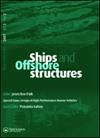更新用于预测搁浅船舶船体大梁坍塌的残余强度-损伤指数图
IF 1.8
4区 工程技术
Q2 ENGINEERING, MARINE
引用次数: 0
摘要
十年前,作者提出了残余强度-损伤指数图的概念,以方便快速预测受损结构的屈曲坍塌。他们展示了这一方法。本文章由计算机程序翻译,如有差异,请以英文原文为准。
Updating the residual strength – damage index diagrams for hull girder collapse predictions of grounded ships
A decade ago, the authors introduced the concept of residual strength-damage index diagrams to facilitate rapid predictions of buckling collapse in damaged structures. They demonstrated this approa...
求助全文
通过发布文献求助,成功后即可免费获取论文全文。
去求助
来源期刊

Ships and Offshore Structures
ENGINEERING, MARINE-
CiteScore
4.50
自引率
14.30%
发文量
164
审稿时长
7.5 months
期刊介绍:
Ships and Offshore Structures is an international, peer-reviewed journal which provides an authoritative forum for publication and discussion of recent advances and future trends in all aspects of technology across the maritime industry.
The Journal covers the entire range of issues and technologies related to both ships (including merchant ships, war ships, polar ships etc.) and offshore structures (floating and fixed offshore platforms, offshore infrastructures, underwater vehicles etc.) with a strong emphasis on practical design, construction and operation.
Papers of interest to Ships and Offshore Structures will thus be broad-ranging, and will include contributions concerned with principles, theoretical/numerical modelling, model/prototype testing, applications, case studies and operational records, which may take advantage of computer-aided methodologies, and information and digital technologies. Whilst existing journals deal with technologies as related to specific topics, Ships and Offshore Structures provides a systematic approach to individual technologies, to more efficiently and accurately characterize the functioning of entire systems.
The Journal is intended to bridge the gap between theoretical developments and practical applications for the benefit of academic researchers and practising engineers, as well as those working in related governmental, public policy and regulatory bodies.
 求助内容:
求助内容: 应助结果提醒方式:
应助结果提醒方式:


